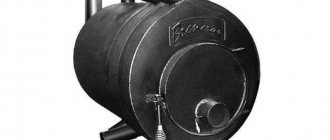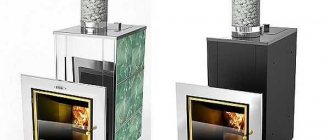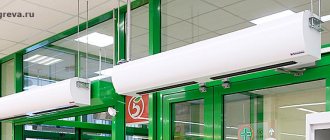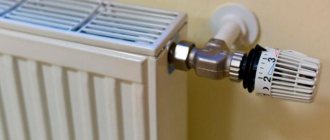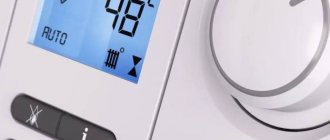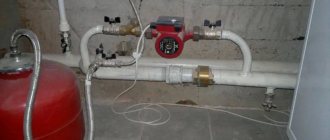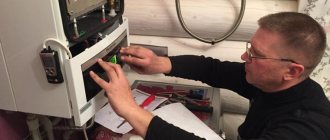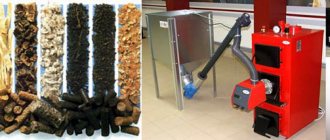Productive and economical liquid fuel heating boilers allow you to achieve complete autonomy from the centralized gas pipeline. When thinking about installing a unit, you need to understand its structure, operating principle and operating features.
The choice of boiler should be based on a comparative assessment of the characteristics and functionality of different models. An important factor is the reputation of the manufacturer.
In this material we will talk about the types of liquid fuel models of heating boilers, their advantages and disadvantages, and also consider several popular devices from well-known brands.
Definition of the concept
There is no mental refinement in defining this type of heating boiler. Liquid fuel boilers are boilers that run on liquid fuel such as diesel fuel, also known as diesel fuel.
The main purpose of a liquid fuel boiler is to heat the house by heating the coolant of the heating circuit. Depending on the brand of the boiler, it can perform an additional function, namely, heat water in the water supply system, creating a hot water supply circuit. In general, no super tasks, just the usual tasks of all heating boilers.
Oil evaporation technology
In furnaces of this type, it is not the oil that burns, but its vapor. That is, the waste material is heated up before combustion begins, it begins to evaporate, and the vapors are already ignited. This technology allows dirty, heavy, poorly burning fuel to be decomposed into “lighter” components, and then burned. It is this that, with correctly selected parameters, allows you to achieve virtually smokeless and complete combustion of fuel, in which there are practically no emissions: everything burns.
Do-it-yourself boiler for testing: the principle of a boiler based on oil evaporation
The simplest and most effective way to implement this technology is to use a hot bowl into which waste material drips.
When it comes into contact with hot metal, the oil suddenly evaporates, the vapor mixes with the air supplied here, flares up and burns. The amount of heat generated during this process is large. To achieve maximum efficiency and complete combustion, the burning mixture must remain in the combustion chamber for a long time. Therefore, a stationary impeller must be installed at the mouth of the air duct, which will create the required turbulence in the combustion chamber.
A do-it-yourself steam boiler for testing can be implemented in this form
Despite the high efficiency and “omnivorous” nature, this operating principle is rarely implemented in factory boilers produced in the USA and Europe. But Russian manufacturers produce test boilers that use evaporation technology. The main stumbling block in the implementation of such boilers is the method of preheating the bowl. Those who make these boilers on their own do it simply: throw a wick soaked in gasoline into the bowl, pour in a little diesel fuel or the same gasoline, set it on fire, waiting until the bowl warms up to the required temperatures. After this, the oil supply is opened.
In Europe and the USA, such a solution is unacceptable: it is unsafe. But our manufacturers also use this particular method of igniting their stoves.
Another option for a furnace with a plasma bowl
The video demonstrates one of the options for heating a garage using a working furnace. But this option does not implement a drip supply of fuel: it flows in a trickle and does not burn completely
It is for this reason that the author of the project paid such attention to the insulation and sealing of all removable parts: to minimize the entry of smoke into the room and made a high chimney for better draft
Liquid fuel boilers and fuel
It so happens that when talking about household liquid fuel boilers, it is a priori understood that these boilers run on diesel fuel (diesel fuel). In fact, the burners of these boilers can also operate on other types of liquid fuel (which should be indicated in the documentation):
- Kerosene;
- Light oil;
- Various oils;
- Fuel oil.
The main requirement for fuel is the absence of moisture and the absence of abrasive impurities. It is also worth noting that each type of fuel affects the performance of the boiler and the frequency of its maintenance.
It is also important to understand that the fuel on which the boiler operates must be indicated in the documentation for the boiler and there are no omnivorous liquid fuel boilers yet.
What to look for when choosing
When choosing a liquid fuel unit, in addition to the thermal power, which must provide all the heat losses of the building and the load on the hot water supply, it is important to pay attention to the types of acceptable fuel.
It is necessary that, according to GOST, it corresponds to the one that the owner plans to use and which is available in sufficient quantities in the area of residence to eliminate high transportation costs.
Liquid fuel heating devices work with a fuel system; it is important that the automation unit is consistent with its operation. For example, if in an emergency the heating boiler suddenly turns off, after the shut-off valve is cut off, the fuel must be returned back to the storage container.
Typically, the fuel system is not included in the delivery of the unit, so you will have to install it yourself. Some models are equipped with a fuel heater in front of the injector; attention must also be paid to this in order to take into account the fuel parameters at the outlet of the fuel supply system.
Conclusions on consumption (calculation No. 1)
Based on the given fuel consumption data, you can estimate the cost of heating for the season.
- We take the heating season to be 6 months, or 180 days.
- For a house of 300 meters, a 30 kW boiler is required (1 kW per 10 meters).
- We choose a boiler from the list above at 34.9 kW, which consumes an average of 12 liters of diesel fuel per day. (10.0-14.5 l).
- The maximum fuel consumption for 180 days will be 180×14.5=2610 liters.
- We understand that no one will heat at maximum the whole season. We assume that for 90 days of the heating season the boiler operates at 100%, and for 90 days at 50%.
- We get: 90×14.5+90×14.5/2=1305+652.5=1957.5 liters.
- Diesel fuel 1957.5 liters costs (retail 38 rubles) 74385 rubles (1240 rubles per month).
In the article “Simplified calculation of the heating system,” I showed the calculation based on the power of the heating boiler. Below there will be another calculation that will show different results.
Prices: summary table
| Model | Available power, kW | Number of circuits | Efficiency, % | Cost, rub. |
| Kiturami Turbo 13R | 13, 17, 21, 30 | double-circuit | 86 | 43 000 |
| Ferroli ATLAS 32 | 32, 47, 62, 78, 95 | single-circuit | 64,3 | 63 000 |
| ACV N3 | 16, 25, 30, 51 | single-circuit | 90 | 93 000 |
| NORTEC B70 (WB 40) | 40, 59, 147, 197 | single-circuit | — | 159 000 |
DieselLiquid fuel BoilersWaste oil
Advantages of liquid fuel boilers
- There are quite obvious advantages of liquid fuel boilers used in industries related to fuels and lubricants. For private homes, the advantages of boilers of this type may raise questions:
- Liquid fuel boilers have a high efficiency of 86 to 98%. This is a good indicator, and it is very close to the indicators of gas boilers;
- An undoubted advantage of diesel boilers, unlike gas boilers, is that you do not need permits (approvals) to install the boiler. Although the combustion room will still have to be equipped;
- Diesel boilers are produced in the most autonomous configurations. Automation of boilers and automatic fuel supply allow minimizing the presence of a person for maintenance;
- Another plus is the ability to quickly and easily, by changing the boiler burner, switch to working with natural gas;
- Although there are no omnivorous boilers, diesel boilers can operate on alternative types of liquid fuel, as indicated in the documentation for the boiler;
- Liquid fuel boilers can fit into any heating system and can work with any coolant (water and antifreeze).
The best known manufacturers and models: characteristics and prices
Kiturami Turbo 13R
The most common and one of the best liquid fuel boilers for heating a private home in the budget price category. This is a diesel double-circuit model, the primary heat exchanger is steel, the secondary (for hot water supply) is copper. The fuel consumption of the 13 kW model is 1.97 kg/hour (2.25 l/hour), quite average, but sufficient. In general, the model is characterized by the minimum required set of components and the minimum required operating efficiency, due to which it is possible to maintain one of the lowest prices on the market.
At the same time, the boiler is known for its reliability and trouble-free operation. Separately, it is worth noting the functionality; for this price, the basic package includes a room thermostat - an extremely useful device that affects not only comfort, but also savings. There are all the minimum necessary protective systems and auto-diagnostics. Available in 13, 17, 21 and 30 kW versions.
Ferroli ATLAS 32
Universal Italian boiler with replaceable burner (diesel gas). Known for its high reliability, cast iron heat exchanger and efficiency of 94.3%. Users like to note the extremely quiet operation of an oil-fired boiler. There is protection against overheating and freezing, it is possible to connect an external thermostat, but it is not included with the boiler.
The only drawback is the lack of low-power models. Available in versions with heating outputs of 32, 47, 62, 78 and 95 kW. Please note that it is usually sold without a burner, which must be purchased separately. Diesel fuel – SUN G burner, gas – SUN M burner.
ACV N3
Another universal gas-diesel model made in Belgium. A diesel burner here also needs to be purchased separately; burners BMR 31, BMV 1FV, BMV 2FV can be installed on this model. Unlike the previous Ferroli, here the heat exchanger is made of furnace steel, however, based on the experience of other models, even steel heat exchangers from ACV have never had any questions, as with all boilers in general. The manufacturer is known for the practicality and absolutely trouble-free boiler units. However, the price is corresponding, in our opinion, too high; if the budget is strictly limited, this model is not the best choice.
There are protections against overheating, lack of traction, low-temperature corrosion, there is a connector for external control, but the thermostat itself is not included in the basic configuration. The body is thermally insulated; owners note the low noise level of the burners.
NORTEC B70 (WB 40)
Domestic model that burns waste oil. Despite the low cost for boilers of this type, the amount is still significant and will only pay off when used in a large private house (from 300-400 m2) with permanent residence; purchasing such equipment for a summer residence with temporary residence is irrational. In addition to mining, it is capable of burning fuel oil, heating oil and even crude oil. The 40 kW model consumes up to 4 l/hour of fuel.
From the factory, the boiler is already equipped with all the necessary components of the fuel unit - a transfer pump, a disposable fuel filter and a fuel intake. Equipment of this type uses extremely wear-resistant and durable materials that do not raise questions about reliability. In this model, the automation is equipped with the minimum necessary functionality: a basic set of protection systems and the ability to set the temperature in the system. Due to its simplicity, there are also no problems with it.
Cost: 146,000-175,000 rubles.
Disadvantages of liquid fuel boilers
When choosing a boiler, the disadvantages of liquid fuel boilers are more important.
- First of all, these are the costs of arranging a combustion room, building a chimney and installing a fuel tank with a capacity of 500-3000 liters. You can’t install such a tank in a house (although they do), which means you need space on the property. Installing a large tank is also expensive and requires adherence to technology.
- The combustion room is needed to hide the noisy operation of boilers of this type. In addition, burning diesel fuel is accompanied by oil odors.
- Environmental authorities may have big questions about tank equipment. All these are additional costs.
- Modern liquid fuel boilers are expensive, and fuel costs exceed the cost of other types of fuel.
- Another pitfall is high requirements for fuel quality. This may be a regional (local) problem.
Steam boilers D-900, D-721GF.
Boilers D-721GF and D-900 designed to produce steam at a temperature not higher than 115 °C with an excess pressure of up to 0.07 MPa (0.7 kgf/cm2) in order to supply technological processes of various types of production, hot water supply, heating and other purposes.Advantages of boilers D-721GF, D-900:
|
Technical characteristics of boilers D-721GF, D-900:
| D-721-GF | D-900 | |
| Type | Stationary, horizontal, smoke-fired, three-way | Stationary, horizontal, smoke-fired, three-way |
| Operating mode according to the main technological process | Auto | Auto |
| Steam capacity for normal steam, kg/h. | 750 | 900 |
| Thermal power, kW, not less | 630 | 670 |
| Efficiency, %, not less | 90 | 91 |
| Steam parameters: — permissible excess pressure, MPa (kgf/cm2) — temperature at g. pressure above 0.05 MPa | 0.07 (0.7) not higher than 115°C | 0.07 (0.7) not higher than 115°C |
| Type of fuel | Low pressure natural gas | Liquid heating fuel |
| Fuel consumption, kg/h | no more than 64 | no more than 63.5 |
| Drive unit | Electric 3 phase. 50 Hz, 220/380 V | Electric 3 phase. 50 Hz, 220/380 V |
| Installed electric drive power: — burners, kW — water treatment systems, kW | 2.2 0.85 x 2 = 1.7 | 2.2 0.85 x 2 = 1.7 |
| Service life before write-off, years not less | 5 | 5 |
| Warranty period of operation, years, not less | 1 | 1 |
| Weight (without mounting parts), kg, no more | 1650 | 1650 |
| Specific material consumption, kg/kg steam, no more | 2,4 | 2,4 |
| Overall dimensions, mm, no more - length - width - height (without chimney) | 3300 1400 2250 | 3180 1460 2600 |
| Number of explosion valves, pcs. | 1 | 1 |
| Number of inspection hatches, pcs. | 4 | 4 |
| Safety valve: - type - brand - quantity, pcs. | self-polishing, leverless, cargo KPS-0.7-810 2 | self-polishing, leverless, cargo KPS-0.7-810 2 |
| Level sensor type | Electrode (3 electrodes) | Electrode (3 electrodes) |
| Air and gas pressure control sensors | Pressure meters NPM-52 | |
| Time to reach operating mode, h, not less | 0,25 | 0,25 |
| Heated area, m2 | 6000 | 6000 |
How much fuel is needed for the season?
One of the most important questions to decide is how much fuel you will need for the season. Let's count.
Simplified, it is considered that:
- 1 liter of diesel fuel allows you to heat an area of up to 100 meters within an hour.
- The boiler consumption is calculated as the power of the burner used multiplied by 0.1.
- And as always, 1 kW of the boiler will heat 10 square meters. meters of house.
Let's make an approximate calculation, from the word example.
- Let our house be 300 meters, as in the calculation above. To heat a well-insulated house, we need a 30 kW boiler. Boiler efficiency is 93%. The burner of such a boiler will burn 32.2 kW × 0.1 = 3.2 liters of fuel per hour. This is 77.4 liters per day.
- The heating season is counted as 180 days (6 months). The maximum fuel consumption in the so-called continuous mode will be: 13932 liters (14 tons). Wow!
- We understand that the boiler will not operate at full capacity all season. For the calculation, it is assumed that the boiler will be used for half a season at 50%. Therefore, for the season for a house of 300 meters we will need:
- 90×77.4+90×38.7=6966+3483=10449 liters.
- Price: 10,449 liters×38 rubles=397,062 rubles (66,177 rubles per month). An unrealistic amount.
A logical question arises: Why, compared to the calculation using the passport (above), did this calculation above give completely different results and where is the correct calculation?
I answer: The error is 72 liters per day. Not one diesel boiler will work 24 hours a day.
As I said, diesel boilers have very serious automation. The boiler will be turned off for 2/3 days, not turned on. Therefore, the calculation should include not 24 hours of work, but 8 hours. That is, the fuel needed for the season is not 10,449 liters, but 3,483 liters.
In addition, modern boilers have technological tricks that also reduce fuel consumption, for example, multi-stage burners, burners with turbo circulation.
One more thing. The calculation given at the beginning of the article is based on the passport data of the boilers, which were compiled taking into account the quality of the fuel in the country of origin. Also, the boiler consumption indicated in the passport is slightly underestimated, since it implies ideal insulation of the house, the outside temperature is minus 10-15˚C and is given for an already heated house (heat maintenance mode).
Therefore, the correct calculation of fuel consumption for the heating season will be somewhere in the middle between 1957.5 liters according to the passport and 3483 liras according to the calculation. We remember that I considered the house to be 300 meters away.
Equipment classification
Depending on the requirements for the equipment, a specific boiler model is selected. Characteristics that are important when selecting a heating boiler:
- power;
- combustion type;
- heat exchanger material;
- fuel consumption;
- additional possibility of heating water.
Inside view of an oil-fuel boiler Source stroyfora.ru
See also: Catalog of companies that specialize in insulating houses.
Power
The efficiency of diesel fuel consumption and the operating efficiency of the unit depend on the power consumption. The generally accepted unit of power measurement is kilowatt. This characteristic must be reflected in the documentation supplied with the boiler.
The selection of a model based on power must be made based on the area of the heated room of the house. Calculating the required power is quite simple: sum up the area of all rooms, and the resulting amount must be divided by 10. This formula is used to determine the power of a boiler for a house located in a temperate climate.
This calculation method is suitable for rooms in which the ceiling height is no more than 3 m. If the building is located in an area with a cold climate, then the calculated power of the unit must be increased in the range from 20 to 30%.
Comparison of the power of boilers of different types in the table Source pechilux.ru
Determination of fuel consumption
Diesel heating of a private home requires significant consumption of diesel fuel. This indicator depends on the power of the boiler equipment. The amount of fuel can be calculated using the formula: divide the boiler power by 10. The resulting quotient is the hourly fuel consumption (in kilograms) during heating.
In temperature maintenance mode, fuel consumption is significantly reduced. How economically diesel fuel will be consumed depends on the quality of the building’s thermal insulation. If it is weak, the flow rate will decrease by a third; if it is good, it will decrease by up to 70%. The average fuel consumption for a private home is usually from 500 to 900 grams.
Boilers for heating and heating
Diesel boilers can be used not only to heat a house, but also to heat water. Devices that combine both of these functions are called dual-circuit.
If this is the option you need, the calculated power must be increased by a fifth. This factor must be taken into account immediately. Otherwise, the power of the diesel boiler may not be enough for both water heating and heating.
Heating system for heating a house and heating water Source teplotehnika.msk.ru
Heat exchanger: choice of material of manufacture
The boiler heat exchanger material is one of the important parameters. During fuel combustion, soot is formed, which, when combined with condensate, leads to corrosion and failure of the unit. Each heat exchanger material has its own strengths and weaknesses, including resistance to corrosion and temperature changes.
Cast iron
A heat exchanger made of cast iron has higher corrosion resistance compared to steel. But at the same time it can crack due to temperature changes. Cast iron is heavier than steel and its price is higher.
Steel
The steel body is lighter and cheaper than cast iron, it is resistant to temperature changes, but is susceptible to corrosion. Stainless steel has the best performance qualities. But such a boiler will cost more.
When choosing a diesel boiler, you can start from financial capabilities, but do not forget about the quality and duration of operation Source happymodern.ru
How does an oil-fuel boiler work?
The operation of diesel fuel boilers is similar to the operation of a gas boiler. The leading role is played by a burner with a fan. She sprays fuel. In the combustion chamber, the fuel mixes with oxygen (air) and ignites. The combustion of the fuel mixture heats up the heat exchanger with the coolant.
In a double-circuit boiler, there is a second circuit through which water flows from the water supply system, creating a hot water supply system.
Speaking about the similarities in the operation of gas and diesel boilers, it is worth remembering that most liquid fuel boilers can be quickly converted to operate on gas (and vice versa). Only the boiler burner is replaced and that’s it.
For example, the De DietrichGT123 boiler runs on liquid fuel or gas. When purchased, it works with a pressurized liquid fuel burner, which can be replaced with a gas burner to operate on gas. The diagram shows a similar Kiturami double-circuit boiler.
Operating principle and device
Liquid fuel devices operate on the same principle as gas ones. The main difference is the use of a nozzle (fan burner). The boiler has the following structural elements:
- common building;
- burner;
- Control block;
- the combustion chamber;
- chimney;
- heat exchanger
The package also includes a pump, which is responsible for supplying fuel to a special tank. To improve efficiency, some manufacturers equip the device with heat exchange plates and chimney pipes.
The control unit is fully automatic. The body is completely thermally insulated. This increases the efficiency of the device and also minimizes heat loss. The outside of the boiler is covered with a special film, which remains cold even when the unit is heated, so there is no risk of burns.
Oil burner
For liquid fuel heating units, fan (pressurized) burners are used. They atomize liquid fuel entering the burner under pressure with the required atomization ratio. Air is also forced into the burner, which is correctly called forced air.
The fuel mixture is ignited by electrodes. Further operation of the boiler is ensured by built-in automation.
Here it’s time to note that the design of boilers contains a lot of electronics and equipment powered by electricity (fans, pumps). This makes diesel boilers electrically dependent and this must be taken into account when purchasing and installing. If your home has frequent electrical problems, then you need to take care of a backup power supply.
Characteristics of fuel oil
There are two types of heating oil used in boiler houses:
- medium fuel grades M40 m M40V;
- heavy fuel – M100, M100V.
In ship installations, light fuel grades F5 and F12 are used.
Elementary composition of fuel oil:
- high carbon content – up to 87%;
- hydrogen – up to 12.5%;
- oxygen and nitrogen – up to 0.5%.
Fuel oil also contains sulfur, which when burned forms sulfur dioxide. The use of this fuel is complicated by the possible presence of water, which leads to a decrease in heat generation and causes corrosion of pipelines and equipment.
The density of fuel oil obtained by direct distillation is less than the density of water; its sedimentation period lasts 4-8 days. Cracking fuel oil has a density that exceeds that of water.
Operational characteristics of fuel oil:
- Viscosity, characterized by the degree of fluidity, is measured by a viscometer. The conditions of transportation, pumping, and combustion of this fuel depend on the value of this parameter.
- The pour point is the temperature at which fuel oil loses its fluidity and becomes a stationary mass; this value is in the range of 10-360C.
- The flash point of a fuel is the temperature at which fuel oil vapors combine with air to form a flammable mixture that ignites when a fire is brought to it. For different brands it ranges from 90-1500C. The self-ignition temperature is 3500C.
To supply fuel oil to the burner, it must be heated to 80-1200C. This process is only applicable to fuel that is under pressure in closed containers - pipes and coils.
Types and operating modes of burners for liquid fuels
Some manufacturers sell liquid fuel heating boilers without burners. And that's why. The choice of burners for liquid fuel is quite large and there are many differences in types and operating modes.
Burner types
There are the following types of burners based on fuel:
- Mono fuel burners. They run on only one type of liquid fuel, usually diesel fuel. To switch to oils, you will have to change the burner nozzles.
- Bi fuel burners. They operate on several, often two, types of fuel. There are combinations: diesel-gas, diesel-wood, diesel-wood-coal, etc.
Types of burners by operating mode
We also pay attention to this:
Single-stage burner. Quite primitive, but because of this it is a reliable burner. Adjustment is made by simply turning the burner on/off. They are distinguished by maximum power output and maximum fuel consumption.
Multi-stage burner. This burner is configured to operate according to complex smooth on/off algorithms through intermediate power values. Such burners are expensive, but they save excellent diesel fuel. Typically, such burners are installed on powerful boilers from 40 kW.
Safe Operation
Liquid fuel boilers are considered high-risk objects. Improper operation of such units not only leads to a violation of thermal conditions, but can cause a boiler explosion or create a fire. Persons over 18 years of age who are certified to know the rules of safe operation are allowed to operate industrial liquid fuel units.
In domestic furnaces installed in residential buildings, the owner of such housing construction bears responsibility for safe operation. Therefore, he is obliged to follow all factory instructions for operating the installed boiler. This applies to the procedures for turning on, turning off, setting the operating mode and operating the fuel facility.
The manufacturer specifies the frequency and types of maintenance work for the unit. It is usually carried out annually before the unit is put into operation. This includes cleaning the external and internal surfaces of the boiler and smoke ventilation systems. Checking the condition of convective heating surfaces, pipelines, shut-off and control valves and primary sensors of the safety system.
Fuel storage tank
Now comes the fun part. An oil-fuel boiler requires a container for storing fuel, and I listed this as a disadvantage a little higher.
The calculations shown above indicate that a capacity of several tons is needed. There is no need to invent anything here and it is better to buy a ready-made container with all the built-in equipment: a float, a vapor outlet, a drain valve, a fuel intake kit, a pipeline for discharging fuel to the burner, etc.
Material for containers is steel, polyethylene, fiberglass.
To install the tank, site preparation, excavation, concreting and a lot of special work will be required. You need to understand this and most likely, you will have to hire specialists.
Automation (control)
According to its characteristics, fuel can be supplied to the boiler independently; it does not need to be thrown in like firewood. Therefore, in boilers of this type, maximum attention is paid to automatic control, which minimizes the presence of a person in the operation of the boiler.
Using the example of the Kiturami boilers I came across, let’s see what is included in the boiler automation. On the body we see sensors for fuel level, temperature, and overheating. Yes, electronic remote control unit. Boiler indicators allow you to monitor the temperature of the coolant in the heat exchanger, circulation pump, burner, and power supply. Tricky buttons “Sleep”, “Shower”, also elements of universal automation. That's a plus.
Fire-tube steam boilers KP low and medium pressure.
Fire-tube steam boilers KP are designed to produce steam for the purpose of heat supply to technological processes, reinforced concrete plants, polystyrene foam production lines, steaming of tanks and fuel and lubricant storage facilities, livestock farms and economic complexes: heat treatment of feed, milk pasteurization, space heating and other purposes.
The standard boiler package includes: boiler, burner, feed pump, level automatics, level sensor unit, pressure gauge, pressure switch, direct-acting water level indicator No. 6, safety valves (2 pcs.), shut-off control valves.
Technical characteristics of low and medium pressure steam boilers:
| KP-75 | KP-100 | KP-150 | KP-250 | KP-300 | KP-500 | KP-600 | KP-800 | KP-1000 | |
| System power, kW | 55 | 70 | 100 | 175 | 205 | 335 | 400 | 550 | 680 |
| Steam capacity, kg/hour | 75 | 100 | 150 | 250 | 300 | 500 | 600 | 800 | 1000 |
| Mains voltage, V/Hz | 220/50 | 380/50 | |||||||
| Working pressure, kg/cm2 | 0,7-4 | 0,7-5 | |||||||
| Steam temperature, oC | 115-145ºС | 115-155ºС | |||||||
| Fuel consumption, | |||||||||
| Diesel, l/h Gas, m3/h | 5.5 6.6 | 7.7 9.3 | 11 13.3 | 16.4 20 | 21.9 26.2 | 32.8 40.9 | 43.8 54.5 | 60 73 | 75 — |
| Efficiency (efficiency),% | 89 | 89 | 89 | 89 | 89 | 89 | 89 | 89 | 88 |
| Steam output Ø, mm | 50 | 76 | flange 80 | ||||||
| Water inlet Ø, mm | 15 | ||||||||
| Exhaust pipe Ø, mm | 145 | 195 | 318 | ||||||
| Weight, kg | 150 | 210 | 350 | 610 | 630 | 760 | 860 | 880 | 920 |
| Dimensions (WxDxH), mm | 1370x1730x1974 | 1370x1730x1974 | 1370x1730x1974 | 1370x1730x1974 | 1370x1730x1974 | 1970x1930x1974 | 1970x2000x2095 | 1970x2010 x2300 | 3000x2200x2200 |
It is possible to supply boilers with a steam output of up to 2000 kg/h.
Attention! All information is provided on the site for informational purposes only. The manufacturer reserves the right to change the design, mounting dimensions, technical characteristics, and appearance of the product without prior notice.
Before purchasing a product, be sure to clarify the parameters you are interested in.
conclusions
If in your area there are problems with gasification, and you cannot get additional power for an electric boiler, but you need heating in the house and you need hot water, then liquid fuel boilers are what you need.
©Obotoplenii.ru
More articles
- Kiturami liquid fuel boilers: descriptions of popular models
- Wissmann liquid fuel boilers: description, features, models
- Liquid fuel boilers Protherm review, advantages, assembly, installation
- Liquid fuel boiler, design and operation
High-pressure water-tube steam boilers KP.
Water-tube steam boilers KP are designed to produce steam for the purpose of heat supply to technological processes, polystyrene foam production lines, steaming of tanks and fuel and lubricant storage facilities, livestock farms and economic complexes: heat treatment of feed, pasteurization of milk, space heating, etc.
The standard boiler package includes: boiler, burner, make-up pump, feed tank for collecting condensate, automatic make-up, water level sensor in the tank, pressure gauges, pressure and dry-running switches, direct-acting water level indicator, safety valves (2 pcs.), frame, shut-off control valves.
Technical characteristics of high pressure steam boilers:
| KP-150 | KP-250 | KP-300 | KP-500 | KP-600 | KP-800 | KP-1000 | KP-1600 | |
| System power, kW | 100 | 175 | 205 | 335 | 400 | 550 | 680 | 1100 |
| Steam capacity, kg/hour | 150 | 250 | 300 | 500 | 600 | 800 | 1000 | 1600 |
| Mains voltage, V/Hz | 220/50 | 380/50 | ||||||
| Working pressure, kg/cm2 | Up to 16 | |||||||
| Steam temperature, oC | Up to 220ºС | |||||||
| Fuel consumption, | ||||||||
| Diesel, l/h | 11 | 16.4 | 21.9 | 32.8 | 43.8 | 60 | 75 | 115 |
| Gas, m3/h | 13.3 | 20 | 26.2 | 40.9 | 54.5 | 73 | — | — |
| Efficiency (efficiency),% | 89 | 89 | 89 | 89 | 89 | 89 | 88 | 89 |
| Steam output Ø, mm | 50 | |||||||
| Water inlet Ø, mm | 15 | |||||||
| Exhaust pipe Ø, mm | 390 | |||||||
| Weight, kg | 1350 | 1400 | 1450 | 1500 | 1550 | 1600 | 1700 | 1800 |
| Dimensions (WxDxH), mm | 2300x1500x2000 | 2300x1500x2000 | 2300x1500x2000 | 2300x1500x2000 | 2300x1500x2000 | 2300x1500x2400 | 2300x1500x2400 | 2300x1500x2400 |
It is possible to supply boilers with a steam output of up to 2500 kg/h.
Attention! All information is provided on the site for informational purposes only. The manufacturer reserves the right to change the design, mounting dimensions, technical characteristics, and appearance of the product without prior notice.
